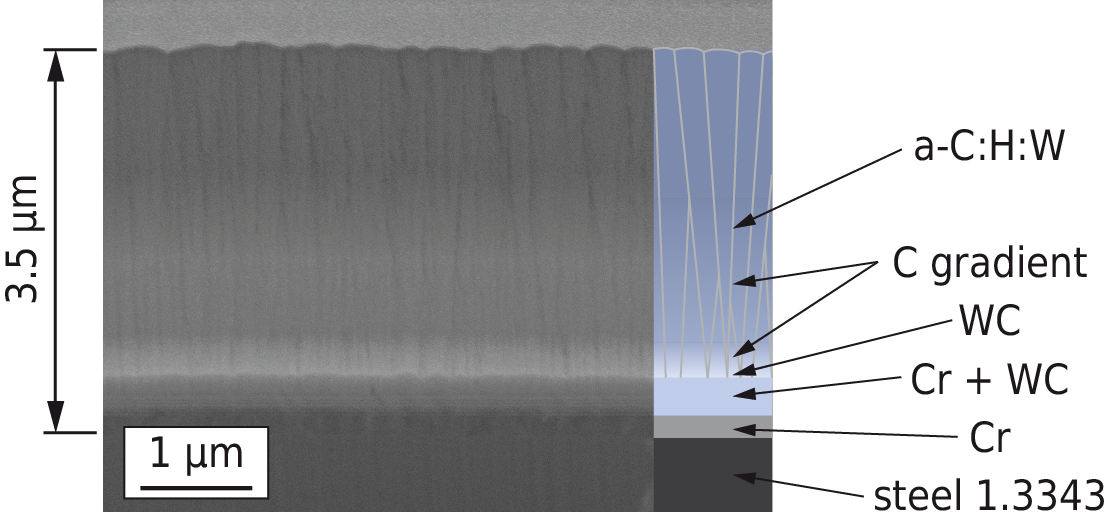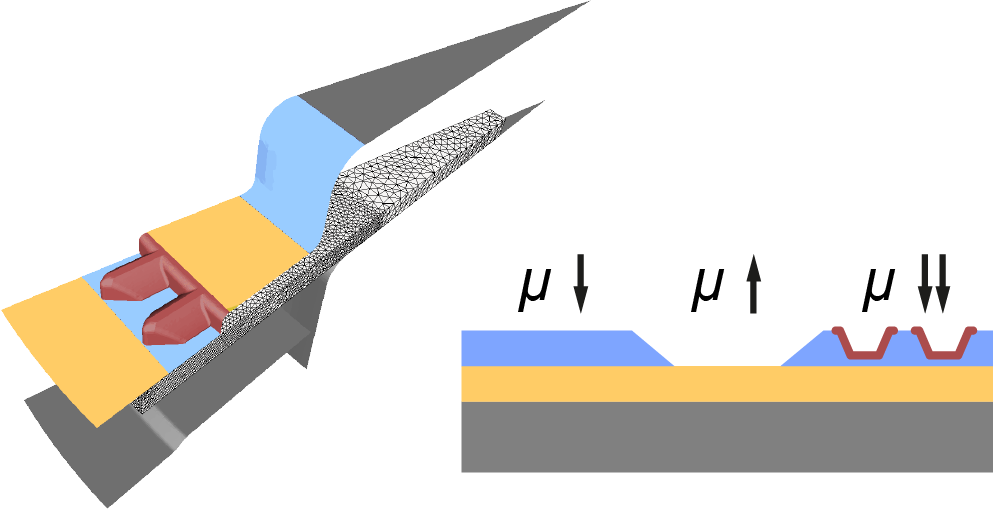B4 - DLC Coatings for Forming Tools (funding period 2)
Tribological DLC coatings in combination with surface texturing for forming tools to increase lifetime and to improve process quality
Project Status: finished
Last Update: 23.01.2017
Members
- Prof. Dr.-Ing. Sandro Wartzack (until 31.03.2021)
- Prof. Dr.-Ing. Stephan Tremmel (until 31.03.2021)
- Prof. Dr.-Ing. Stephan Tremmel (until 31.03.2021)
- Prof. Dr.-Ing. Sandro Wartzack (until 31.03.2021)
- M.Sc. Tim Weikert (until 31.12.2020)
- Dr.-Ing. Harald Hetzner (until 31.08.2013)
Proposer
Head of Project
Researcher
In the first phase of TCRC 73, it was shown that, in sheet bulk metal forming (SBMF), locally adapted friction properties of the contact tool/workpiece are mandatory for an effective control of the material flow. This is the way to form complex variants of sheet metal components in compliance with the quality requirements and under avoidance of unwanted changes in the part geometry, as they are caused by geometric flow restrictions. In subproject B4, a new methodology was developed, enabling a tribology-oriented system analysis during the early phases of the tool and process design. From the large group of DLC coatings, tungsten-modified hydrogenated amorphous carbon (a-C:H:W) was selected as the most promising tool coating. The typical architecture of such a coating system is shown in Fig. 1. In tribological-mechanical load-scanning tests under application-oriented conditions and accompanying microstructural analyses, these DLC variants showed the most beneficial property profile. Further, in the course of systematic coating development, based on design of experiments, it could be shown that the coefficient of friction of low-wear a-C:H:W coatings can be adjusted by proper choice of the deposition parameters. In dry sliding against steel, the friction coefficient could be varied between 0.05 and 0.4. Under lubrication with forming oil, a variation in the range of 0.04 to 0.11 was possible.

Fig 1: Typical architecture of a coating system with functional layer of a-C:H:W
The vision of TCRC 73 is enabling the production of complex components with variants in shortened process chains, and hence at higher economic benefit, by combining the advantages of sheet and bulk metal forming. In order to reach this vision, locally adapted tribological properties of the forming tools are an essential element. For this reason, also in the second phase, subproject B4 makes an important contribution to the development of tool surfaces with process-adapted tribological properties. Therefore, the a-C:H:W-based coating systems that were developed in the first phase, will be further tribologically and mechanically optimised. The objective is providing tailored friction properties and, at the same time, protecting the tools more effectively against adhesive material transfer. As it has emerged, that, under high loads, micro-scale pick-up of counter body steel is responsible for the initiation of mechanical damage of the coatings in the first place, the focus is on a further improvement of adhesion protection, besides increasing the fracture strength of the coatings. Adhesion protection may be increased by additional doping elements, like silicon. The mechanical and structural properties can be further improved by adapting the different coating layers to each other. The coatings are analysed in application-oriented testing processes, like the ring compression test (TP C1).
Motivated by the broad range of different friction properties which can be realised by targeted adjustment of the process parameters during the deposition of a-C:H:W, the future contribution of coatings to a locally adapted tribology is to be maximised. Besides a synergetic combination with surface micro-structures, it is strived to make the design element tool coating contribute to tailored friction by itself (Fig. 2). For this reason, strategies for the selective application of different coating variants on the same tool surface are investigated. Hence, single layers of different coating types and variants are combined to multi-layer coating systems. By selective removal, or alternatively by use of masking techniques, the properties of different tribologically functional coating layers take effect in different surface zones of the forming tools. The locally effective coating system are evaluated in application-oriented testing processes in order to get some information about the tribological-mechanical properties especially in the interface between different surface zones.

Fig. 2: Vision of an SBMF tool with different tribological zones, realised by combination of locally applied coatings and surface micro-structures.
Working Groups
- Component Properties and Function (funding period 2)
- Materials (funding period 2)
- Tools (funding period 2)
Publications
2016
- Löffler, M.; Andreas, K.; Engel, U.; Weikert, T.; Tremmel, S.; Wartzack, S.; Stangier, D.; Tillmann, W.; Merklein, M.: Surface modifications for adaption of tribological conditions in sheet-bulk metal forming processes. In: Bobzin, K.; Bouzakis, K.-D.; Denkena, B.; Maier, H.J.; Merklein, M. (Edt.): Proceedings THE "A" Coatings, (2016), PZH Verlag, pp. 13-20
- Kersting, P.; Gröbel, D.; Merklein, M.; Sieczkarek, P.; Wernicke, S.; Tekkaya, A.; Krebs, E.; Freiburg, D.; Biermann, D.; Weikert, T.; Tremmel, S.; Stangier, D.; Tillmann, W.; Matthias, S.; Reithmeier, E.; Löffler, M.; Beyer, F.; Willner, K.: Experimental and numcerial analysis of tribological effective surfaces for forming tools in Sheet-Bulk Metal Forming. In: Production Engineering, 10(2016)1, Springer, pp. 37-50
- Löffler, M.; Engel, U.; Schulte, R.; Gröbel, D.; Krebs, E.; Freiburg, D.; Biermann, D.; Stangier, D.; Tillmann, W.; Weikert, T.; Wartzack, S.; Tremmel, S.; Lucas, H.; Denkena, B.; Merklein, M.: Tribological measures for controlling material flow in sheet-bulk metal forming. In: Production Engineering, 10(2016), pp. 459-470
- Weikert, T.; Tremmel, S.: Influence of bias voltage and layer thickness variation on mechanical properties and tribological behavior of a-C:H:W multilayer coatings. In: Proceedings of the 17th Nordic Symposium on Tribology - NordTrib 2016, (2016), published on CD
- Weikert, T.; Tremmel, S.; Wartzack, S.: Gezielte Anpassung lokaler Reibungszustände unter Einsatz wolframmodifizierter amorpher Kohlenstoffschichten. In: Bartz, Wilfried J. (Edt.): Tribologie und Schmierungstechnik, 63(2016)5, Renningen: Expert Verlag GmbH, pp. 5-11
2015
- Zhao, R.; Weikert, T.; Tremmel, S.; Wartzack, S.: Tribological behaviour of tungsten doped hydrogenated amorphous carbon coatings deposited under various bias voltages and argon flows. In: Book of Abstracts of the 11th Coatings Science International 2015, (2015), pp. 140-144
- Löffler, M.; Freiburg, D.; Gröbel, D.; Loderer, A.; Matthias, S.; Stangier, D.; Weikert, T.: Untersuchung von Tailored Surfaces hinsichtlich ihres tribologischen Einflusses auf Prozesse der Blechmassivumformung. In: Tekkaya, A. E.; Liewald, M.; Merklein, M.; Behrens, B.-A (Edt.): Tagungsband zum 18. Workshop Simulation in der Umformtechnik & 3. Industriekolloquium Blechmassivumformung 2015 - DFG Transregio 73, (2015), Aachen: Shaker Verlag, pp. 131-146
- Weikert, T.; Tremmel, S.; Wartzack, S.: Gezielte Anpassung lokaler Reibungszustände unter Einsatz wolframmodifizierter amorpher Kohlenstoffschichten (a-C:H:W). In: Gesellschaft für Tribologie e.V. (Edt.): 56. Tribologie-Fachtagung. Reibung, Schmierung und Verschleiß. Forschung und praktische Anwendungen. Band 1, (2015), Göttingen, pp. 24/1-24/10
2014
- Schmid, C.; Hetzner, H.; Tremmel, S.; Hilpert, F.; Durst, K.: Tailored Mechanical Properties and Residual Stresses of a-C:H:W Coatings. In: Advanced Materials Research, 996(2014), Dürnten (Schweiz): Trans Tech Publications Ltd, pp. 14-21
- Zhao, R.; Weikert, T.; Tremmel, S.; Wartzack, S.: Untersuchung des tribologischen Verhaltens wolframmodifizierter amorpher Kohlenstoffschichten (a-C:H:W) bei systematischer Variation der Biasspannung und des Argonflusses während des Beschichtungsprozesses. In: Gesellschaft für Tribologie e.V. (Edt.): 55. Tribologie-Fachtagung. Reibung, Schmierung und Verschleiß. Forschung und praktische Anwendungen. Band 2, (2014), Göttingen, pp. 32/1-32/10
- Hetzner, H.; Schmid, C.; Tremmel, S.; Durst, K.; Wartzack, S.: Empirical-Statistical Study on the Relationship between Deposition Parameters, Process Variables, Deposition Rate and Mechanical Properties of a-C:H:W Coatings. In: MDPI (Edt.): Coatings - Special Issue "Recent Aspects of Thin Films Deposited by Magnetron Sputtering and Emerging Applications", 4(2014), pp. 772-795
- Hetzner, H.: Systematische Entwicklung amorpher Kohlenstoffschichten unter Berücksichtigung der Anforderungen der Blechmassivumformung. Dissertation. Friedrich-Alexander-Universität Erlangen-Nürnberg(2014), published
2013
- Häfner, T.; Reg, Y.; Hetzner, H.; Schmidt, M.: Microstructuring tools for sheet metal bulk forming – a designated application for picosecond laser. In: Journal of Laser Micro Nanoengineering, 8(2013)1, pp. 39-44
- Hetzner, H.; Zhao, R.; Tremmel, S.; Wartzack, S.: Tribological adjustment of tungsten-modified hydrogenated amorphous carbon coatings by adaption of the deposition parameters. In: Bouzakis, K.-D.; Bobzin, K.; Denkena, B. Merklein, M. (Edt.): 10th International Conference THE "A" Coatings, 10.-11. April 2013, (2013), Aachen: Shaker, pp. 39-49
- Wartzack, S.; Hetzner, H.; Tremmel, S.: Amorphe Kohlenstoffschichten für die Blechmassivumformung. In: Konstruktion, 3(2013), pp. 65-66
- Salfeld, V.; Krimm, R.; Behrens, B.; Sieczkarek, P.; Ben Khalifa, N.; Tekkaya, A.; Tremmel, S.; Wartzack, S.: Maschinen- und werkzeugseitige Herausforderungen bei der Blechmassivumformung von komplexen Bauteilen. In: Merklein, M., Behrens, B.-A., Tekkaya, A. E. (Edt.): Tagungsband zum 2. Workshop Blechmassivumformung 2013 - DFG Transregio 73, (2013), Bamberg: Meisenbach , pp. 13-36
Presentations
2016
- 16.06.2016: Weikert, T.: Influence of bias voltage and layer thickness variation on mechanical properties and tribological behavior of a-C:H:W multilayer coatings, Hämeenlinna, Finnland
2015
- 22.06.2015: Zhao, R.: Tribological behaviour of tungsten doped hydrogenated amorphous carbon coatings deposited under various bias voltages and argon flows, Noordwijk, The Netherlands
- 22.09.2015: Weikert, T.: Gezielte Anpassung lokaler Reibungszustände unter Einsatz wolframmodifizierter amorpher Kohlenstoffschichten (a-C:H:W), Göttingen
2014
- 24.09.2014: Zhao, R.: Untersuchung des tribologischen Verhaltens wolframmodifizierter amorpher Kohlenstoffschichten (a‑C:H:W) bei systematischer Variation der Biasspannung und des Argonflusses, Göttingen
2013
- 10.04.2013: Zhao, R.: Tribological adjustment of tungsten-modified hydrogenated amorphous carbon coatings by adaption of the deposition parameters, Aachen






